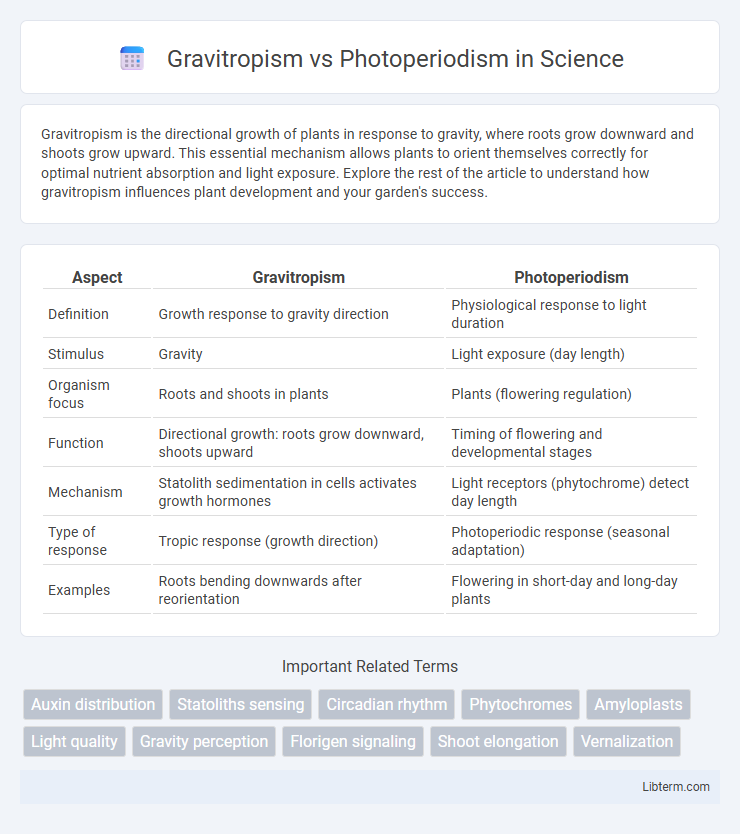Gravitropism is the directional growth of plants in response to gravity, where roots grow downward and shoots grow upward. This essential mechanism allows plants to orient themselves correctly for optimal nutrient absorption and light exposure. Explore the rest of the article to understand how gravitropism influences plant development and your garden's success.
Table of Comparison
| Aspect | Gravitropism | Photoperiodism |
|---|---|---|
| Definition | Growth response to gravity direction | Physiological response to light duration |
| Stimulus | Gravity | Light exposure (day length) |
| Organism focus | Roots and shoots in plants | Plants (flowering regulation) |
| Function | Directional growth: roots grow downward, shoots upward | Timing of flowering and developmental stages |
| Mechanism | Statolith sedimentation in cells activates growth hormones | Light receptors (phytochrome) detect day length |
| Type of response | Tropic response (growth direction) | Photoperiodic response (seasonal adaptation) |
| Examples | Roots bending downwards after reorientation | Flowering in short-day and long-day plants |
Introduction to Plant Tropisms
Plant tropisms are growth responses directed by environmental stimuli, crucial for plant adaptation and survival. Gravitropism refers to a plant's growth orientation in response to gravity, influencing root and shoot direction, while photoperiodism involves growth and developmental changes triggered by light duration, affecting flowering and seasonal behaviors. Understanding these mechanisms reveals how plants optimize resource use and reproductive timing through environmental signal integration.
Defining Gravitropism
Gravitropism is the directional growth response of plants to gravity, where roots exhibit positive gravitropism by growing downward and shoots exhibit negative gravitropism by growing upward. This process allows plants to orient themselves correctly in their environment, ensuring roots anchor into the soil while shoots grow toward light. In contrast, photoperiodism regulates flowering and other developmental processes based on the length of day and night rather than growth direction.
Understanding Photoperiodism
Photoperiodism is the physiological reaction of organisms to the length of day or night, primarily influencing flowering time, seed germination, and dormancy in plants. It is regulated by the plant hormone phytochrome, which detects changes in light duration and triggers specific gene expression patterns. Understanding photoperiodism is crucial for optimizing crop yield, enabling precise control over flowering cycles and adaptation to seasonal variations.
Key Mechanisms of Gravitropism
Gravitropism involves the detection of gravity through statoliths--specialized starch-filled plastids--that settle in root cap cells, triggering differential auxin distribution to regulate root and shoot growth directions. The redistribution of the hormone auxin causes cells on the lower side of the root to elongate less, directing growth downward, while in shoots, higher auxin concentration promotes cell elongation upward. This precise hormonal signaling and cellular response enable plants to orient themselves correctly relative to gravity, contrasting with photoperiodism, which relies on light duration perception to regulate flowering and developmental cycles.
Biological Basis of Photoperiodism
Photoperiodism in plants is regulated by the phytochrome system, which detects changes in light duration and quality to control flowering and other developmental processes. This biological mechanism involves conversion between two photoreversible forms, Pr and Pfr, allowing plants to measure day length accurately. Gravitropism, in contrast, relies on statolith sedimentation within specialized cells to perceive gravity, guiding root and shoot orientation.
Environmental Factors Influencing Both Tropisms
Gravitropism and photoperiodism are influenced by key environmental factors such as gravity and light, respectively, which regulate plant growth orientation and flowering cycles. Gravitropism depends on the perception of gravity through statoliths in root cap cells and affects root and shoot growth direction to optimize resource acquisition. Photoperiodism relies on light duration detected by phytochrome pigments, controlling flowering time and seasonal development to align reproductive phases with optimal environmental conditions.
Differences Between Gravitropism and Photoperiodism
Gravitropism is a plant growth response to gravity, directing roots downward and shoots upward, while photoperiodism is the plant's response to the length of day and night, affecting flowering and seasonal development. Gravitropism involves physical orientation of growth organs based on gravitational stimuli, whereas photoperiodism regulates physiological processes tied to light cycles. These distinct mechanisms utilize different sensory receptors--statoliths for gravitropism and photoreceptors for photoperiodism--resulting in varied adaptations to environmental cues.
Examples in Plant Species
Gravitropism is observed in plants such as maize (Zea mays), where roots grow downward in response to gravity, while shoots grow upward, ensuring proper orientation. Photoperiodism manifests in species like soybean (Glycine max), which flowers based on the length of night and day, adapting its reproductive cycle to seasonal changes. Both processes influence plant growth and development by responding to environmental cues like gravity and light duration.
Agricultural Applications and Importance
Gravitropism regulates root and shoot orientation, essential for optimizing plant stability and nutrient uptake in crops, directly influencing yield and soil management practices. Photoperiodism controls flowering time and developmental stages by responding to light duration, critical for synchronizing planting schedules and maximizing crop productivity across different geographical regions. Understanding and manipulating these tropisms enable farmers to enhance crop resilience, improve harvest timing, and increase agricultural efficiency under variable environmental conditions.
Future Research and Innovations
Future research in gravitropism aims to unravel the molecular mechanisms that enable plants to sense and respond to gravity, facilitating advancements in crop resilience and space agriculture. Innovations in photoperiodism are focused on genetic editing technologies like CRISPR to modify flowering times and improve yield adaptability across diverse climates. Integrating these insights can optimize plant growth cycles and enhance agricultural productivity under changing environmental conditions.
Gravitropism Infographic

 libterm.com
libterm.com